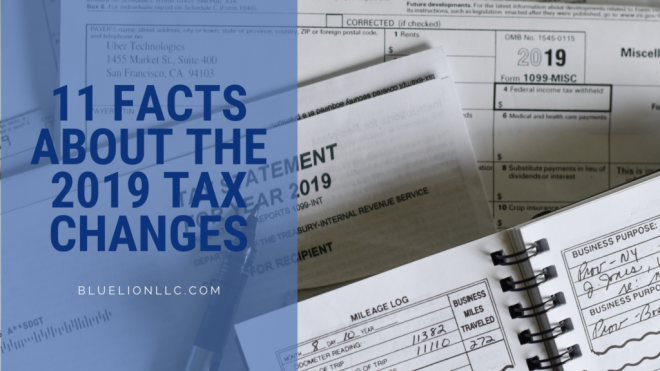
Major changes happened in 2019 to the American Tax Code. Many of you may have received larger tax reimbursements or owed less taxes as the end of the year. However, these tax codes were adjusted MID-YEAR of 2019, so some of these changes will not have such a large impact in 2020! You should check where you are at, and see if you need to adjust your W4 now…MID-YEAR!
IRS Tax Calculator
This calculator will help you figure out where you are at, and where you should be by the end of the year, so you can make those adjustments. If you’re expecting a large return this year, or not to owe, YOU MAY BE WRONG!!! Check the calculator out and see if you need to make a change ASAP!
So, what Happened in 2019 that matters to me?
The Tax Cuts and Jobs Act is the most significant set of changes to the U.S. tax code in several decades. Here’s a rundown of what you MOSTLY need to know about the recent tax changes that could affect YOU.
**This is not to give you tax or legal advice but being educated helps you make better decisions!
- “General” lowering of tax rates
- Image below of what the previous tax rate (FICA) were, and the NEW rates
| FORMER Marginal Tax RATES (2017) | NEW Marginal Tax Rates (2018-2025) | % Change |
| 10% | 10% | – |
| 15% | 12% | -3% |
| 25% | 22% | -3% |
| 28% | 24% | -4% |
| 33% | 32% | -1% |
| 35% | 35% | – |
| 39.6% | 37% | -2.6% |
- Tax Bracket adjustments
- Tax brackets were adjusted. You may fall into a new category.
- If You claim head of household or married filing separately, you can find those changes on IRS. gov
| Marginal Rate | FORMER Single | NEW Single | FORMER Married Filing Jointly | NEW Married Filing Jointly |
| 10% | $0-$9,525 | $0-$9,700 | $0-$19,050 | $0-$19,400 |
| 12% | $9,526-$38,700 | $9,701-$39,475 | $19,051 – $77,400 | $19,401 – $78,950 |
| 22% | $38,701-$82,500 | $39,476-$84,200 | $77,401 – $165,00 | $17,951 – $168,400 |
| 24% | $82,501-$157,500 | $84,201-$160,725 | $165,001 – $315,000 | $168,401 – $321,450 |
| 32% | $157,501-$200,000 | $160726-$204,100 | $315,001 – $400,000 | $321,451 – $408,200 |
| 35% | $200,001-$500,000 | $204,100-$510,300 | $401,000-$600,000 | $408,201 – $612,350 |
| 37% | Over $500,000 | Over $510,300 | Over $600,000 | Over $612,350 |
- Higher Standard Deduction
- This deduction nearly doubled the standard deduction from previous levels.
- You can choose between using the standard deduction or itemized deductions.
- Itemizing deductions means adding up all of the individual tax deductions to which you’re entitled and then subtracting them from your adjusted gross income (AGI).
| Filing Status | 2017 Standard Deduction | 2018 Standard Deduction | 2019 Standard Deduction |
| Single or Married Filing separately | $6,350 | $12,000 | $12,200 |
| Married Filing Jointly | $12,700 | $24,000 | $24,400 |
| Head of Household | $9,350 | $18,000 | $18,350 |
- Removed Personal exemption
- You used to be able to take an exemption (meaning untaxable earnings) of $4,100 for yourself, spouse, and each dependent (no caps).
- Now, you cannot take anything. This is gone.
- Reason: The standard deduction almost doubled, and the child tax credit was adjusted. This made calculating taxes easier.
- Child Tax Credit Doubled
- The Child Tax Credit was increased from $1,000 to $2,000 per qualifying child under age 17.
- As much as $1,400 of this amount is refundable — meaning that it can be claimed even if your federal income tax liability is already zero.
- What is the difference between a deduction and a credit?
- Deductions lower the amount of income that the government considers when taxing you,
- A Credit reduces the amount of tax you owe.
- If you owe $2,000 in tax, a $2,000 credit would pay it off. However, if you owe $2,000 in tax, a deduction would lower the income % rare which would apply to you.
- The Child Tax Credit was increased from $1,000 to $2,000 per qualifying child under age 17.
- Education Tax Breaks – no real change
- Two major credits for college expenses:
- American Opportunity Credit – applies to tuition paid toward a degree or certificate program but only for the first four years of college
- Lifetime Learning Credit – applies to nearly all tuition and fees.
- These are designed to lower the tax bills of people who paid college tuition.
- Two major credits for college expenses:
- Expanded 529 savings plan
- What is that? An education savings account for your child(ren), or a child you want to save money for education.
- These accounts provide a tax-advantaged way to save and invest money for educational expenses such as tuition, fees, books, and certain other qualifying expenses.
- There is no deduction for contributions to these accounts on federal tax returns
- Any money these accounts earn from investments can be withdrawn tax-free when used for a qualified expense.
- Great News: A change was made to allow use of the funds for qualifying educational expenses at any level, not just for college.
- Ex: If you send your child to a private high school, you could potentially use funds from their 529 savings plan to help pay for it.
- Mortgage Interest Still Deductible
- The cap (or limit) on the total deduction allowed has been reduced to the interest on up to $750,000 of qualified residence debt, or mortgage principal on a primary or secondary home.
- This is down from the previous limit of $1 million.
- Mortgages obtained before December 15, 2017 are grandfathered in to the higher limit.
- The previous additional limit that allowed taxpayers to deduct interest up to $100,000 of home equity debt has been eliminated.
- Interest on HELOC (Home Equity Line of Credit) can still be used as a deduction, ONLY if the loan was used to substantially improve your home.
- If it meets this standard, it becomes qualified residence debt and is counted as part of your $750,000 cap.
- The cap (or limit) on the total deduction allowed has been reduced to the interest on up to $750,000 of qualified residence debt, or mortgage principal on a primary or secondary home.
- Charitable Contributions
- Still awesome
- Donate away!
- Still deductible.
- In fact, you can now deduct up to 60% of your AGI on charitable contributions, up from 50%.
- No more Affordable Care Act penalties
- No insurance -no problem
- Live your healthy or unhealthy dreams
- Bye Bye Birdie
- The following deductions are no longer eligible under the new tax code:
- Moving Expenses – you cannot take deductions for moving for job-related purposes anymore, this includes military relocation.
- Casualty and theft losses – If your home is burglarized, you used to be able to deduct the value of the stolen items. Moving forward, you can only deduct for losses attributed to a federally declared disaster.
- The MISC deduction category – There used to be a long list of deductions that you could take advantage of. This included things like un-reimbursed employee expenses, tax preparation expenses, etc.
- The following deductions are no longer eligible under the new tax code:
More tax changes occurred which may affect you, however, this short brief is to touch upon the adjustments which affected the “majority” of Americans. To learn more, you can visit IRS.gov.
The information on this website, including its newsletters, is not, nor is it intended to be legal advice. You should contact an attorney or HR specialist for advice on your individual situation.


